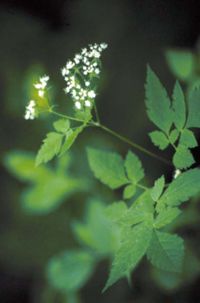Osmorhiza: Difference between revisions
No edit summary |
No edit summary |
||
| Line 1: | Line 1: | ||
{{SPlantbox | |||
|genus=Osmorhiza | |||
|Temp Metric=°F | |||
|jumpin=If this plant info box on watering; zones; height; etc. is mostly empty you can click on the edit tab and fill in the blanks! | |||
|image=Upload.png | |||
|image_width=240 | |||
}} | |||
{{Inc| | |||
Osmorhiza (Greek; referring to the sweet, aromatic, edible roots). Umbelliferae. A small genus of native herbs, 1 to 3 feet high, sometimes called sweet cicely, but the true sweet cicely is Myrrhis odorata, a closely allied European plant, the leaves of which have the scent of anise seed and are used in flavoring. Sometimes listed by dealers in native plants. | |||
Perennial, slender, hirsute or glabrous, with thin soft foliage: Lvs. ternately compound, the lfts. ovate and toothed: fls. very small, white, in small few-rayed umbels; calyx-teeth obsolete: fr. linear, glabrous or bristly; carpel slightly flattened dorsally or not at all; styles long or short; seed-face from slightly concave to deeply sulcate: root thick, aromatic. By some botanists, the name Washingtonia is used for this genus. The plants thrive in moist more or less shady woodsy places. | |||
}} | |||
:''This article is about the North American herb. For the European herb, see [[Cicely]]. | :''This article is about the North American herb. For the European herb, see [[Cicely]]. | ||
{{Taxobox | {{Taxobox | ||
Revision as of 13:46, 25 February 2010
| Osmorhiza subsp. var. | ||||||||||||||||||||||||||||||||||||||||||||||||||||||||
|---|---|---|---|---|---|---|---|---|---|---|---|---|---|---|---|---|---|---|---|---|---|---|---|---|---|---|---|---|---|---|---|---|---|---|---|---|---|---|---|---|---|---|---|---|---|---|---|---|---|---|---|---|---|---|---|---|

|
|
| ||||||||||||||||||||||||||||||||||||||||||||||||||||||
| ||||||||||||||||||||||||||||||||||||||||||||||||||||||||
| Standard Cyclopedia of Horticulture |
|---|
|
Osmorhiza (Greek; referring to the sweet, aromatic, edible roots). Umbelliferae. A small genus of native herbs, 1 to 3 feet high, sometimes called sweet cicely, but the true sweet cicely is Myrrhis odorata, a closely allied European plant, the leaves of which have the scent of anise seed and are used in flavoring. Sometimes listed by dealers in native plants. Perennial, slender, hirsute or glabrous, with thin soft foliage: Lvs. ternately compound, the lfts. ovate and toothed: fls. very small, white, in small few-rayed umbels; calyx-teeth obsolete: fr. linear, glabrous or bristly; carpel slightly flattened dorsally or not at all; styles long or short; seed-face from slightly concave to deeply sulcate: root thick, aromatic. By some botanists, the name Washingtonia is used for this genus. The plants thrive in moist more or less shady woodsy places.
|
- This article is about the North American herb. For the European herb, see Cicely.
| Sweet Cicely {{{status}}} Fossil range: {{{fossil_range}}}
| ||||||||||||||||||||||||||||||||||||||||||||||||||||||||||||||||||
|---|---|---|---|---|---|---|---|---|---|---|---|---|---|---|---|---|---|---|---|---|---|---|---|---|---|---|---|---|---|---|---|---|---|---|---|---|---|---|---|---|---|---|---|---|---|---|---|---|---|---|---|---|---|---|---|---|---|---|---|---|---|---|---|---|---|---|
 Osmorhiza claytonii | ||||||||||||||||||||||||||||||||||||||||||||||||||||||||||||||||||
| Plant Info | ||||||||||||||||||||||||||||||||||||||||||||||||||||||||||||||||||
| ||||||||||||||||||||||||||||||||||||||||||||||||||||||||||||||||||
| Scientific classification | ||||||||||||||||||||||||||||||||||||||||||||||||||||||||||||||||||
| ||||||||||||||||||||||||||||||||||||||||||||||||||||||||||||||||||
| [[{{{diversity_link}}}|Diversity]] | ||||||||||||||||||||||||||||||||||||||||||||||||||||||||||||||||||
| {{{diversity}}} | ||||||||||||||||||||||||||||||||||||||||||||||||||||||||||||||||||
| Binomial name | ||||||||||||||||||||||||||||||||||||||||||||||||||||||||||||||||||
| {{{binomial}}} | ||||||||||||||||||||||||||||||||||||||||||||||||||||||||||||||||||
| Trinomial name | ||||||||||||||||||||||||||||||||||||||||||||||||||||||||||||||||||
| {{{trinomial}}} | ||||||||||||||||||||||||||||||||||||||||||||||||||||||||||||||||||
| Type Species | ||||||||||||||||||||||||||||||||||||||||||||||||||||||||||||||||||
| {{{type_species}}} | ||||||||||||||||||||||||||||||||||||||||||||||||||||||||||||||||||
| Species | ||||||||||||||||||||||||||||||||||||||||||||||||||||||||||||||||||
| See text | ||||||||||||||||||||||||||||||||||||||||||||||||||||||||||||||||||
| [[Image:{{{range_map}}}|{{{range_map_width}}}|]] | ||||||||||||||||||||||||||||||||||||||||||||||||||||||||||||||||||
| Synonyms | ||||||||||||||||||||||||||||||||||||||||||||||||||||||||||||||||||
| {{{synonyms}}} |
Osmorhiza is a genus of North American perennial herbs, known generally as Sweet Cicely or Sweetroot. Osmorhiza longistylis was used by Native Americans to treat digestive disorders and as a wash for wounds.
The seeds of this plant have barbs on the end allowing them to stick to clothing, fur, or feathers.
Species
- O. aristata
- O. berteroi (Tapering Sweetroot, Mountain Sweet Cicely)
- O. brachypoda (California Sweet Cicely)
- O. claytonii (Clayton's Sweetroot, Sweet Cicely)
- O. depauperata (Bluntseed Sweetroot)
- O. glabrata
- O. longistylis (American Sweet Cicely, Sweet Cicely, White Cicely, Longstyle Sweetroot, Aniseroot, Licorice Root, or Wild Anise)
- O. mexicana (Mexican Sweet Cicely)
- O. occidentalis (Western Sweetroot)
- O. purpurea (Purple Sweetroot)
Ref: USDA PLANTS database